Physical Address
304 North Cardinal St.
Dorchester Center, MA 02124
Review diagnostic criteria for the different types of burn injuries.
Review the pathogenesis of the different types of burn injuries.
Review first aid management of burn patients.
Relate extent of burn injury and magnitude of the physiologic stress response.
Review acute management of burn patients, including fluid, nutritional, and wound care.
Review burn wound management.
Learn indications for wound debridement, wound dressing and splinting, and skin grafting.
Discuss advances in rehabilitation of burn trauma survivors.
Aims of burn care:
Rescue : Stop the burn trauma process and provide basic life support.
Resuscitate : Restore vital organ function.
Refer : Triage and possibly transfer to a burn center for multidisciplinary intensive care.
Resurface : Close open wounds as soon as possible.
Reconstruct : Replace damaged anatomic structures.
Rehabilitate : Recover, as far as is possible, physical, emotional, and psychological well-being.
The capability to produce fire (ca. 900,000 BCE) provided humans with transformative new capabilities that advanced human civilization, but there have been consequences. According to the most recent statistics compiled by the World Health Organization and the World Fire Statistics Center (WFSC), fire causes roughly 6.6 million major burn injuries and 400,000 burn-related deaths every year. Major burn trauma is a disease of the poor and disabled. The majority of cases occur in poor neighborhoods and in low-income countries where prevention programs are almost non-existent. The international median burn injury death rate is 0.9–1.2 per 100,000 inhabitants per country. In addition, the cost to society in terms of lost wages, acute medical care, and rehabilitation is significant. In 2009, the WFSC noted that the economic direct cost of fire-related losses ranged from 0.06%–0.26% of countries’ gross domestic product (GDP) with the indirect cost ranging from 0.002%–0.95% of GDP. In economically developed nations, 1%–2% of the population receives a burn injury annually, and 10% of those require professional medical attention. Roughly, 10% of those requiring medical attention have major burns that require burn center management.
Clinically debilitating and life-threatening burn injuries are far more common in economically under-developed communities and nations. Lack of education and awareness regarding the consequences of burn injuries and basic strategies to prevent burn injury are major risk determining factors. In addition to poverty, substance abuse or/and mental illness are significant burn risk factors. For adults, these details include alcoholism, opiate use, senility, psychiatric disorders, and neurological disease such as epilepsy. Of course, some types of employment are associated with higher risk of burn injury. Children under 5 years old are also particularly susceptible to burns and account for 75% of all pediatric burns. Scald burns account for about two-thirds of childhood burn injuries.
Beginning at least 3000 BCE, human suffering from burn trauma resulted in efforts to identify therapies to ameliorate burn morbidity and mortality. In the earliest medical handbook identified (ca. 3rd millennium BCE), an anonymous Sumerian physician documented several burn remedies based on plant extracts. Fifteen hundred years later (~1534 BCE), the Egyptian Ebers Papyrus described a topical compound for treatment for burns consisting of extracts of frog, mud, cow dung, ram’s horn, lemon strips, and a variety of other ingredients. Around 600 BCE, Sushruta first described classic symptoms associated with severe burn injury including thirst and fever. He was also the first to recommend surgical debridement for burns resulting in loose skin and flesh. The Old Testament of the Bible (Leviticus 13:24–28) lists burn injury of the skin among other dermatologic illnesses.
Around 500 BCE, Chinese physicians were using a mixture of tea leaves to treat burns. But the oldest preserved written Chinese scientific description of burn wound treatment dates back to Hong Ge (281–341 CE). His book Zhou Hou Fang (Prescriptions for Emergency) suggested the topical application of two different prescriptions: old (imperative) calcarea optionally blended with plant oil, or the use of pig fat cooked with willow bark. The application of these mixtures resulted in reduced numbers of wound infections and has to be regarded as the oldest preserved Chinese description of an anti-infectious astringent to be used in thermal injuries.
Hippocrates (460–377 BCE) also wrote extensively on burns. He recognized that significant fluid loss occurred at the burned surface as fluid egressed from blood vessels to form blisters. He also described several aspects of burn management, including hydrating the patient, topical occlusive dressing with tree bark extract containing salicins, and surgery for the most severe cases. Perhaps most importantly, Hippocrates advocated that wound care be performed in aseptic conditions and as quickly and painlessly as possible.
Centuries later, the 16th-century German physician Fabricius Hildanus was the first to classify burns into three categories that could be used to guide treatment. Around this time, the French surgeon Paré also described areas of the body prone to burn contracture and advocated for early excision of the burn wound. Richter (1788) later wrote on the relationship between burn wound size and prognosis. Debates would continue for centuries about how to best classify and treat burn wounds as well as about which factors – in addition to burn wound size – must be considered when predicting outcome.
Major advances were made in burn care in the 19th century. The first dedicated burn center opened in 1848 when James Syme, a burn surgeon at the Royal Infirmary in Edinburgh, designated one building for all burn patients. Additionally, physicians described excision of burnt tissue and skin grafting, which led to an important publication in JAMA (1905) advocating for early skin grafting. Physicians also began to appreciate the importance of intravenous fluids in acute burn management after Tappeiner (1881) demonstrated that burn physiology results in a hemodynamic picture similar to that of acute pancreatitis.
Clearly, the largest strides in burn care advances have been made in the last century. Sentinel events such as the World Wars and the discovery of antibiotics facilitated major change in medical and surgical care of burns. During World War I, the British plastic surgeon Sir Harold Gilles performed the first successful autograft. His work also facilitated improved techniques for tangential excision of burned skin, donor site harvest, meshing of skin grafts, and the use of cadaveric grafts.
In the 1930s, the Yale surgeon Frank Underhill reported that hypovolemic burn shock occurred in major burn patients and was essentially due to trans-capillary leakage that was eventually found to be caused by the release of damage associated inflammatory mediators into the systemic circulation. Through this process, burn shock may result in decreased intravascular volume, inadequate tissue perfusion, and early post-burn mortality. Stanley Levinson, a surgery resident in Boston at the time, similarly observed that large surface area burn patients often lose fluids at a rate incompatible with life. Drs. Oliver Cope and Francis D. Moore proposed to administer fluid resuscitation, including proteins, at a rate that was linked to the percentage of body surface area burned. Therefore, he advocated for adequate fluid resuscitation as a cornerstone of acute burn care. Charles Baxter at the Parkland Hospital in Dallas promoted the use of lactated Ringer’s solution over colloid to avoid pulmonary edema. This is called the Parkland Burn Resuscitation Formula. Another important shift in burn care was borne from Levinson’s comprehensive description of the pathology and effects of smoke-inhalation injury. This research has led to advances in treating patients with smoke-inhalation injury as well as the initiation of public health safety measures to decrease the risk of smoke inhalation including the development of smoke detectors.
The recent improvements in burn care are largely the result of the comprehensive treatment of burn patients in dedicated burn units and a team approach to burn care. Multidisciplinary teams consisting of plastic or general surgeons, intensivists, psychiatrists or psychologists, nurses, dietitians, therapists, pharmacists, social workers, and spiritual leaders are now the standard at burn centers. In addition, a better understanding of acute burn resuscitation, wound care management, and early excision and skin grafting in severe burns has reduced the mortality rate associated with burns.
Stedman’s Medical Dictionary lists more than 22 types of burn injury including thermal, chemical, electrical, friction, cement, and other “burns”. The pathogenesis of each burn type is quite distinct, which causes some confusion because they are all labelled burn injuries. What they do have in common is that the process begins with damaging molecular structure of tissue. Although the treatment of these different injuries would have aspects in common, there are differences that address the specific pathogenesis.
A thermal burn results when tissue temperature exceeds the level in which molecular kinetic energy exceeds the bond energies that stabilize biomolecular structure. This results from conduction, convection, and/or radiative heating and are usually not spontaneously reversible, although immediate cooling can modify some critical aspects. Thermal burn injury may also result from internal heat generation in diseases such as malignant hyperthermia. The extent of tissue heat damage depends on the tissue type, the immediate tissue temperature history, and the amount of preconditioning.
Cells have the capabilities to increase their tolerance to heat stress through an adaptive preconditioning process. This process involves upregulating synthesis of stress proteins that repair or remove heat-damaged molecules, seal membrane disruptions, and suppress oxidation stress. Only when the extent of thermal damage exceeds cellular repair capabilities does loss of cell and subsequent tissue viability result, which manifests as a burn injury. Basically induced thermal tolerance increases cellular injury repair rates, thus allowing tissues to subsequently survive more than normal heat exposure.
Characteristic molecular alterations that occur at supraphysiological temperatures include disruption of cell membranes, aggregation of unfolded proteins, onset of a cellular oxidative stress response to unfolded proteins in cellular organelles and in the cytoplasm, and extracellular damage to collagen, non-collagenous proteins, and activation of degradative proteases, vascular disruption with hemorrhage, blood coagulation, and dehydration. Of course, the skin temperature history (i.e., magnitude and duration) in nearly all cases of skin burn injury is anatomically non-uniform, which results in a non-uniform distribution of thermal burn injury and is clinically classified according to skin burn depth ( Fig. 18.1 ).
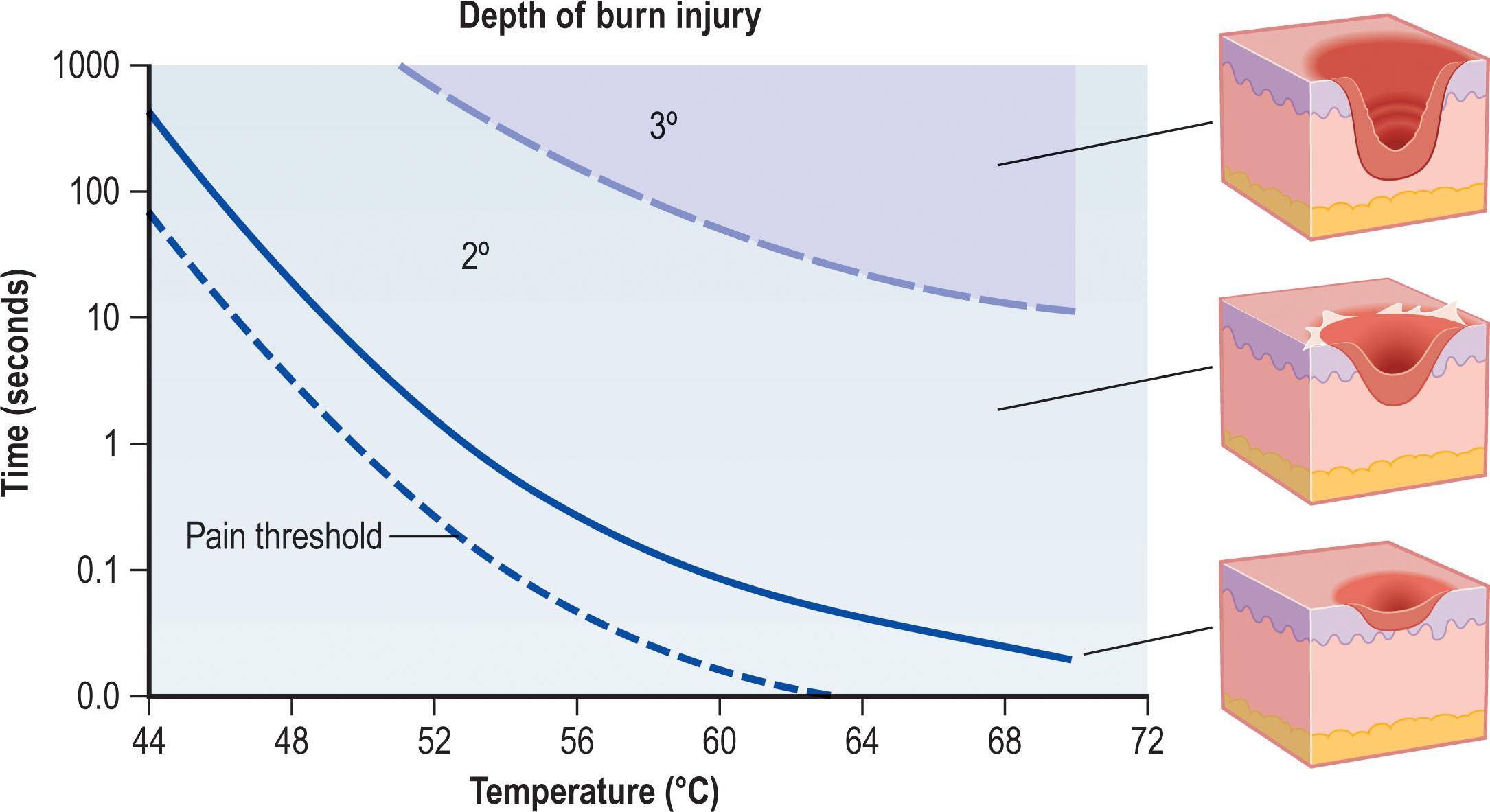
Although the tissue damage mechanisms associated with “flash” and “flame” burns are similar, they are used in different ways. Both flame and flash phenomena pertain to hot, ionized combustion aerosols emanating from a fire or explosion. Flash and flame burn injuries are the most common cause of adult burn admissions. Flame burns result from exposure to heat produced by an ongoing fire. The exposure likely involves longer contact time because it involves a human response time. This results in deeper burn injuries such as partial- and full-thickness skin burns. In contrast, flash burns result from brief exposure to a propagating thermal energy pulse emanating from ignition of flammable gases, high-energy electrical arc ( Fig. 18.2 ), or ionizing radiation. Although the temperatures of arc or flash may reach 10–20 thousands of degrees, they are composed of gases with very low heat capacity which means the efficiency of heat energy transfer is fortunately low. Because of this and the brief exposure, flash burns usually do not penetrate clothing. Typically, flash burns are manifested only on exposed areas of skin and are superficial.
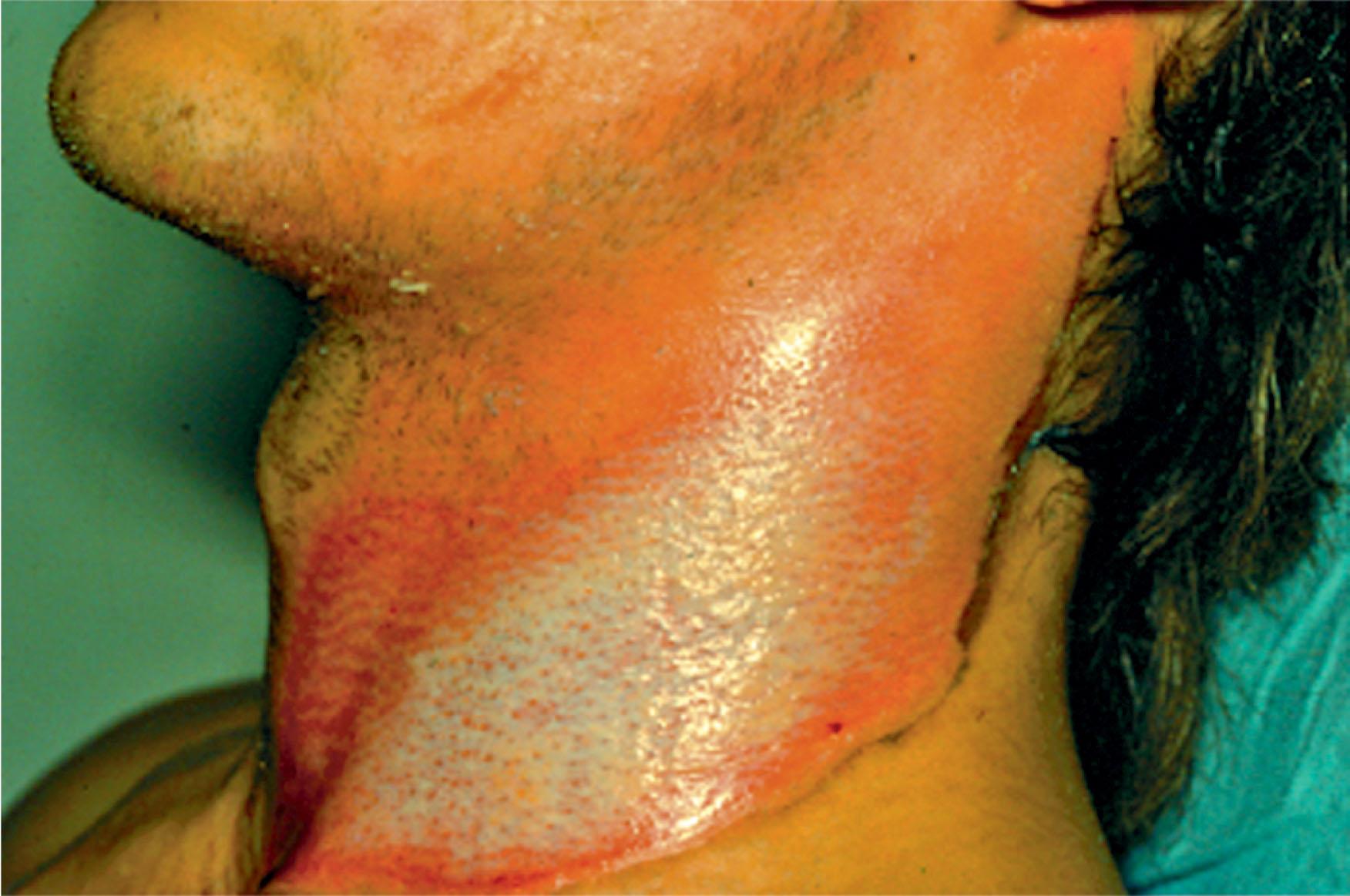
Scald burns result from skin contact with hot liquid or steam. In modern societies, scald burns are second in incidence to flame burns. Most often, the burns result from a cooking accident and often involve a mixture of water and grease. Tragically, children are the most common victims.
Scald burn depth is often more difficult to clinically judge because scalds are lower temperature thermal injuries than flame injury ( Fig. 18.3 ). This is particularly true for patients with darker skin. Thus, scald-injured skin’s structural changes are less noticeable compared to flame burns unless there are petechial hemorrhages visible indicating rupture of mid-dermal and subdermal microvasculature. In the absence of petechial hemorrhage, the depth of scald burn skin injuries is often not visually apparent for 48–72 hours when the manifestation of autolytic degradation is obvious. Duration of hot liquid contact is a major deterministic factor in the depth of burn in scald injuries. Thus, hot water immersion scalds are typically deeper than a hot water spill scald with liquid at the same temperature. Skin surface contact with 60°C (140°F) water creates a deep dermal burn in 3 seconds but will cause the same injury in 1 second at 69°C (156° F). Also, the burn tends to be a bit deeper in skin folds and clefts.
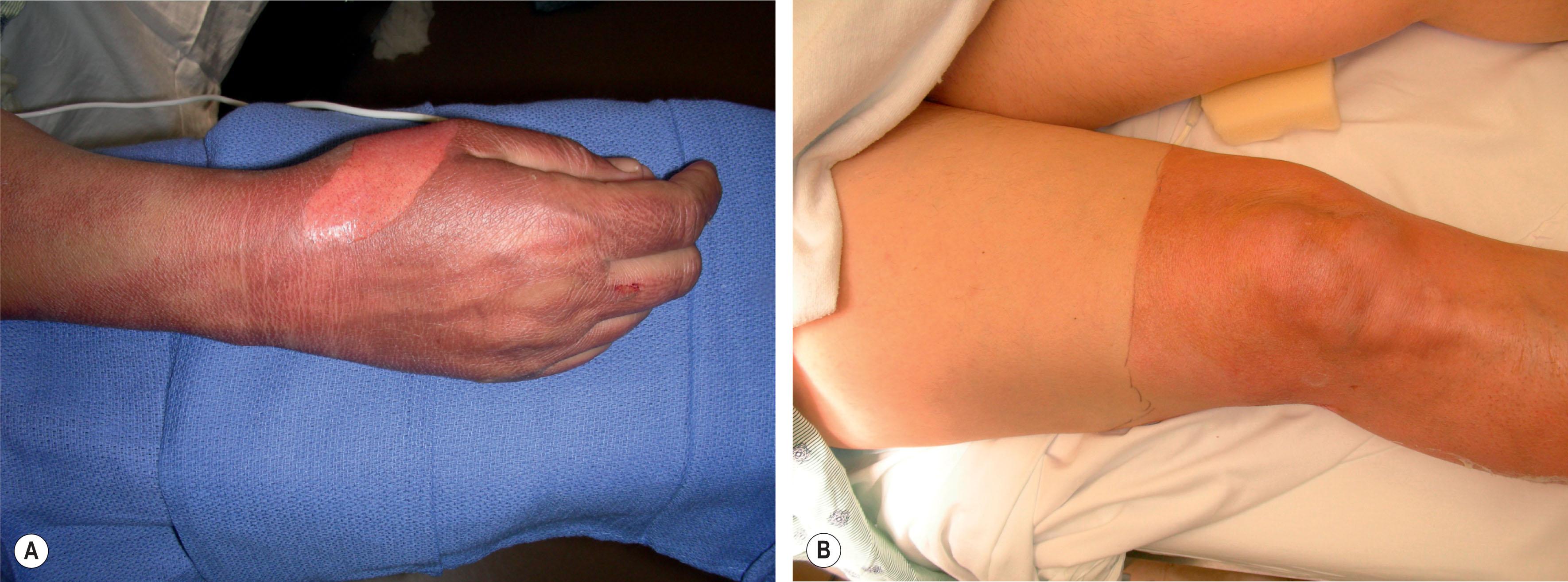
Scald burn damage kinetics depend on the barometric pressure, being slower in higher altitudes than at sea level. Unless superheated at pressures higher than 1 atmosphere or in a microwave, the maximum skin temperature reached in hot water can be 100°C at sea-level. Also, because wet skin cools by evaporation, the duration of tissue contact with scalding temperatures depends on factors that limit evaporation rate such as clothing, oil, or other water vapor barriers. If the water contains oils or lipids, as in soups, evaporative cooling is slowed, resulting in longer burn duration and a deeper skin injury.
Contact burns involve mechanical contact with a hot, thermally conducting object (e.g., cooking pan or radiator). Domestic contact burns are caused by direct mechanical contact with lit cigarettes, space heaters, stoves, ovens, irons, exhaust pipes, etc. Resultant burn depth depends on the capability to transfer heat energy to the skin. Thus, skin contact with a hot metal rod can be expected to produce a deeper burn than a hot plastic rod at the same temperature.
Contact burns are often associated with workplace-related hands, patients prone to seizures, and use of intoxicating substances. They are also seen in elderly people after a loss of consciousness; such a presentation requires a workup of the cause of syncope. In the industrial setting, contact burns commonly result from contact with hot metals, thermoplastic composites, glass, or coals. Because the heat energy transfer is large, contact burns often involve full-thickness skin and subcutaneous tissue.
Hot tar and asphalt burns occur in workers engaged in surfacing pavement and roads, roofing, and other industrial applications. Tar is an oil composite that solidifies when cooled to body surface temperatures. When hot tar makes contact with skin, it adheres and solidifies in the wound making it difficult to remove without causing further injury. The tar usually retains sufficient heat to produce prolonged damaging temperatures resulting in deep skin burns. Tar itself is also chemically toxic to tissues.
Often, the tar is cool by the time the patient arrives at the medical facility. Injuries typically occur on the exposed skin of the face and extremities, and the burn is of variable depth ranging from deep partial to full thickness.
Electrical injuries represent 3%–5% of burn trauma admissions. However, injuries are often among the most devastating and therefore challenging to manage. Electrical injuries are more difficult to clinically assess because tissues can be injured by either or both thermal and non-thermal injury processes. Furthermore, various modes of electrical injuries can result from electrical current exposure at any frequency in the electromagnetic spectrum ( Table 18.1 ). The abbreviation “DC” (i.e., direct current) indicates the current frequency to be zero, the current flows constantly in one direction, and “AC” (i.e., alternating current) indicates that the current is changing direction of flow (i.e., alternating polarity) with time. The injury mode(s) depend on the voltage, power capacity, and frequency of the power source. The vast major of electrical shock patients seeking medical attention have had contact with commercial electrical power sources which operate between 50 and 60 Hz (i.e., 1 Hz = 1 wave cycle per second). However, electrical power in the form of radiowaves, microwaves, infrared, visible, and ionizing irradiations are also capable of inflicting injury, and they each have unique pathophysiology and clinical manifestations.
| Frequency range | General applications | Tissue injury pathway |
|---|---|---|
|
Commercial electric power; battery power | Joule heating; cell membrane electroporation of nerve and skeletal muscle cells |
|
Radio-communication; diathermy; electrocautery |
|
|
Microwave heating | Dielectric heating of free water |
| Terahertz | Industrial and biomedical imaging applications | Dielectric heating of bound water and proteins |
|
Photo-optical and ionizing irradiation (ultraviolet, X-ray, gamma, etc.) | Heating and direct protein damage; oxidative damage |
At frequencies greater than approximately 50,000 Hz (i.e., low frequency radio waves), electrical power can radiate across air gaps from the power source into the body. However, the body does not absorb ambient radio waves very efficiently, so very high power is needed to cause injury. However, a thermal burn injury can result when direct mechanical contact is made with an energy low radiofrequency power source. Electrocautery devices used for surgical procedures operate in the low radiofrequency range. At much higher frequencies, mechanical contract with the conductor is not required for tissue injury. Common domestic microwave ovens operate in the gigahertz frequency range (10 9 Hz), and infrared food warmers operate in the terahertz (10 18 Hz) range. Although they induce electrical current flow in tissues, these devices cause injury by heating rather than cellular disruption by electrical forces (i.e., electroporation). Accidental brief microwave and infrared radiation burns are usually superficial. To summarize the effects of electrical shock over a range of electrical field frequencies, Table 18.1 presents a classification of electrical injury according to frequency regime.
Electrical shocks from commercial electrical power are the second most common cause of workplace injury. The clinical manifestations depend on the amount of electrical current, the duration of contact, and the anatomic path of the current through the body. When relating the amount of current to the contact voltage, the length of the current path between electrical contact points, the resistance of skin coverings such as gloves, shoes, and clothing are essential to consider. With moist skin, the VLF electrical resistance of a current path from one hand to the other is about 1000 ohms and from hand to both feet is about 750 ohms. The highly resistive epidermal layer is instantly penetrated by voltages greater than 60–100 volts.
For triage purposes, electrical shock injuries are often categorized as “low-voltage” or “high-voltage” depending on whether the contact voltage is below or above 1000 volts, respectively. The scientific basis for this stratification is not clearly defined, but it does correlate with the probability that arc-mediated electrical contact will precede direct body mechanical contact with the energized conductor. For low-voltage shocks, direct mechanical contact with the power source is usually required to initiate current flow, whereas for high-voltage shocks, the current begins to flow through an electrical arc before mechanical contact is made. Some have proposed a mid-voltage (i.e., 400–1000 volts) shock category which makes medical sense in terms of predicting therapy and prognosis. In addition, other important injury-determining factor parameters are duration of electrical contact and the anatomic path of the current through the body. For example, although static electrical shocks typically involve more than 1000 volts, they do not cause injury because the current is small and it only passes on the outer surface of the body.
If mechanical contact with the power source occurs, it can be difficult to impossible to voluntarily disconnect from the contact because the skeletal muscle stimulation is dominated by the electrical shock current rather than the central nervous system. Thus, shock times are typically longer in low-voltage shocks. Electrical shock by commercial electrical power can produce a range of neuromuscular effects ( Table 18.2 ). Of course, the most life-threatening is the immediate risk for cardiopulmonary arrest when the current passes through the heart, especially during the myocardial repolarization phase.
| Physiological consequence of50–60 Hz current (path: hands to feet) | Threshold current (milliamps) |
|---|---|
| Tingling sensation/perception | 1–4 |
| “No let go”(i.e., hand and forearm skeletal muscle tetany) | 16–20 |
| Respiratory muscle paralysis | 20–50 |
| Cardiac arrhythmia (possibly VF) | 50–120 |
In the case of contact with an energized high-voltage conductor, electrical arcing will mediate electrical current flow to the victim before mechanical contact. This introduces a third mechanism of injury: mechanical trauma from the thermoacoustic blast. This is a particularly important mechanism of injury and mortality in short circuits involving very high capacity electrical power in a closed space. The gases released from the arc will further short circuit paths that generate thunderous pressures and temperatures. High-voltage contact arcs can reach very high temperatures leading to corneal burns and clothing ignition.
A common misconception is to identify skin contact wounds as “entrance” and “exit” wounds. The skin contact wounds resulting from passage of commercial AC current are all “entrance” and “exit” wounds because the current travels in and out of each body contact ( Fig. 18.4 ). If the skin is wet, especially from salt water, the skin’s electrical resistance drops allowing subcutaneous tissue damage to occur without skin burns. For electrical shock injury, the skin surface area damage is not reflective of the injury extent. The damage is more volumetric and scattered along the current path, often requiring diagnostic imaging to locate and quantify ( Fig. 18.5 ).

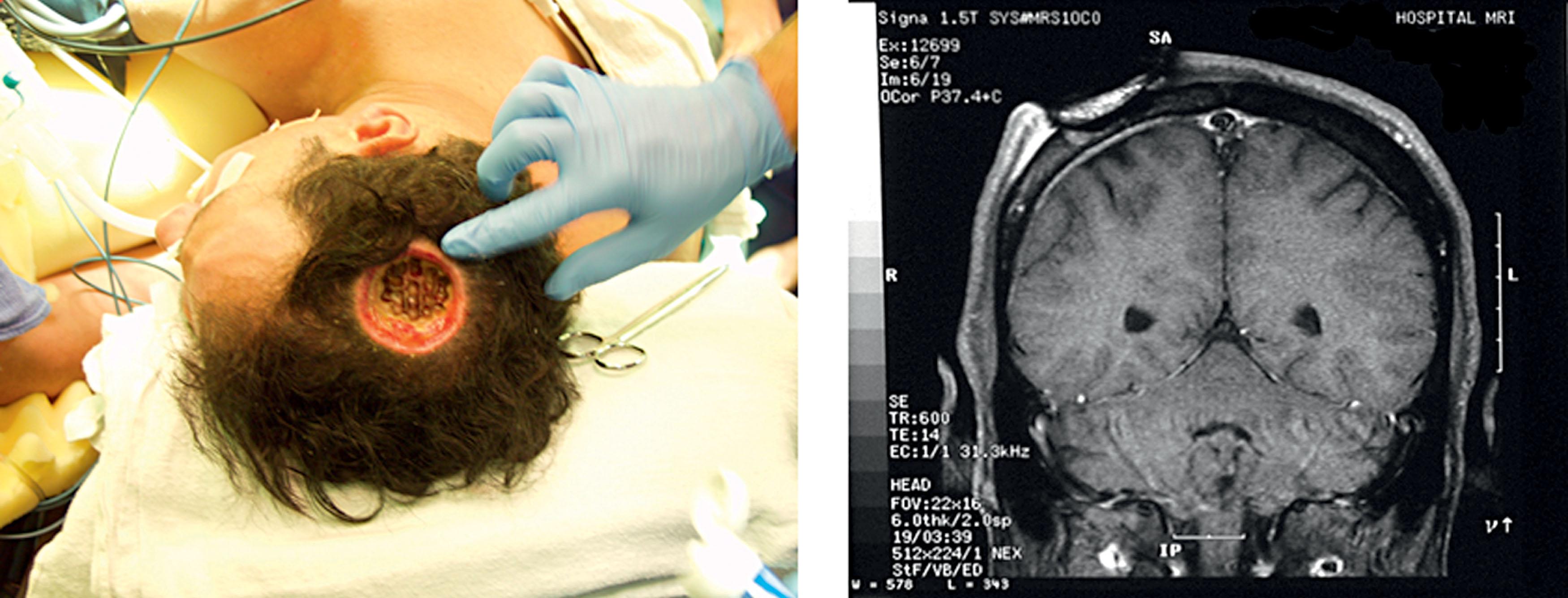
Peripheral nerve and skeletal muscle tissues are most vulnerable to the damaging effects of the electrical field during electrical shock. Just 14–16 milliamperes of current passing through the forearm induces tetanic contractions of muscles controlling handgrip, which may prevent a person from voluntarily releasing the electrical conductor (see Table 18.2 ). Joint dislocations and fractures may result from the muscle spasm as well. A current of 50 milliamperes or more passed through the chest can result in cardiopulmonary arrest within 1 second. Non-thermal electric injury to nerves and muscles can occur in milliseconds while taking seconds for burns to occur. Thus brief shocks commonly result in neuromuscular function disturbances in the absence of thermal burns.
Disruption of skeletal muscle membranes leads to release of myoglobin and hemoglobin that enter the circulation and muscle edema, which results in muscle compartment syndromes. Release of myoglobin into the urine is a characteristic feature of severe electrical shock injury. Renal failure may result from intrarenal aggregation of myoglobin. Direct electrical shocks to the head may cause increased intracranial pressure as well. Case reports of electrical injury also have been reported secondary to cardioversion.
Lightning is another common form of electrical shock. Approximately 200 deaths occur per year in the United States due to lightning injury. Most of the lightning current passes along the skin surface and around the body to ground through the lightning arc. There are often superficial epidermal burn marks that have a characteristic fern-leaf pattern, but the burn does not extend into the dermis for various reasons. Cardiac and central neurological arrest often occurs due to the magnetic pulse-induced electrical currents. Transient central and peripheral neurological arrest is called keraunoparalysis that causes delay in recovery of brain function as well as autonomic nervous system malfunction. CNS viability signs are not useful to guide CPR efforts. Thus, CPR should be continued longer than for other causes of cardiac arrest. Peripheral autonomic neurological malfunction can persist for longer time periods in lightning injury survivors.
Radiation injury results from tissue absorption of either ionizing or non-ionizing radiating electromagnetic waves or both at doses above tissue tolerance. Sub-atomic particle beam irradiation is classified as ionizing irradiation because it can ionize molecules that absorb the particle. Radiation effects on tissue are dependent on both fraction of the radiation energy absorbed and the relative biological effectiveness of the absorbed radiation on the tissue. Both of these factors depend on the tissue type, water content, oxygenation, and other variables.
Regarding non-ionizing radiation, such as infrared or microwave radiation, the radiating energy is absorbed by tissue molecules resulting in tissue heating. Light is absorbed at the sub-molecular level, resulting in heating and shifts in electron orbitals, but does not have enough energy to ionize the molecule. Intense laser light may cause thermal burns or explosive water boiling to disrupt tissues. Non-ionizing radiation from a hot fire or an electrical arc is a frequent cause of industrial thermal burns.
Ionizing radiation transmits higher energy and shorter wavelength than non-ionizing radiation. Ionizing radiation disrupts atomic structure and causes chemical reactions in the tissue. In tissue, water is the primary absorber. Ionizing irradiation causes water and molecular oxygen to react and produce hydroxyl radicals with an unpaired electron in the valence shell. Unpaired radicalized electrons on the outer shell are very reactive with other biomolecules causing damage to DNA, proteins, lipids, etc. Most commonly, the cell and extracellular matrix damage is caused by generation of hydroxyl (OH*) free radicals in oxygenated water. The higher the tissue water and oxygen content, the greater the radiation-induced cell injury.
The intensity of ambient ionizing irradiation energy to which a person can be exposed is measured in Roentgens (R); the amount absorbed into the tissue is measured in Gray (Gy). For a typical person, absorbing X-ray or gamma-ray doses greater than 5 Gray (Joules/kilogram) to a body part like the hand or scalp causes molecular alterations in proteins and nucleic acids that results in radiation fibrosis or burns. With preconditioning that upregulates DNA repair and intracellular protein removal mechanisms, higher doses of radiation could be better tolerated by tissue. Total body absorption of more than 2–3 Gy is associated with a high mortality rate.
The most common cause of radiation burn is heavy sun exposure. Sunlight produces a wide spectrum of radiating energy from infrared to cosmic energies. In typical sunburn, it is the heavy dose of the infrared heating and ionizing ultraviolet (UV) that does the most damage. Cosmic irradiation also contributes. UV radiation produces aqueous phase oxidative free radicals in the epidermis and dermis. When free radical scavenging mechanisms are exceeded, biomolecular damage occurs. It is rare that the burn depth is greater than epidermal or superficial dermal. Also, nucleic acids are able to directly adsorb some wavelengths of UV radiation known as the UVB wavelength spectrum. UVB radiation causes direct damage to DNA in the form of cross-links and double-stranded breaks. If this damage is not reparable by the cell the result is an increased risk of cell death or malignant transformation. Clinical manifestations are painful partial-thickness burns and blistering. Sunscreen lotions absorb the UV and increase the amount of sun exposure required to cause a burn. However, until recently they did not totally shield the entire UV range. There is some evidence that use of narrow-band (i.e., UVB) sunblock is associated with other long-term consequences related to prolonged exposure to DNA reactive irradiation outside of the blocked UVB band.
Radiation injuries also occur from therapeutic, accidental, space travel, or military use of ionizing irradiation. The molecular target of the radiation depends on the type of radiation. Severe immune compromise due to neutropenia and bleeding secondary to thrombocytopenia are seen over a period of 3–5 weeks. At higher levels of exposure (30–100 Gy), the membranes of cells, even non-proliferating nerves and muscle, are damaged leading to loss of tissue viability within 6–24 hours. Radiation injury during space travel is a major unsolved problem. Outside of planetary magnetic fields, the electrons emitted from the sun at relativistic speeds would certainly cause burns and must be shielded. Also, subatomic particles, especially fragments of heavy metal nuclei (High Z), traveling through space are almost impossible to shield. Of course, such High Z radiation would damage tissue.
Basic differences between modes of cellular burn injury can be appreciated in Fig. 18.6 .
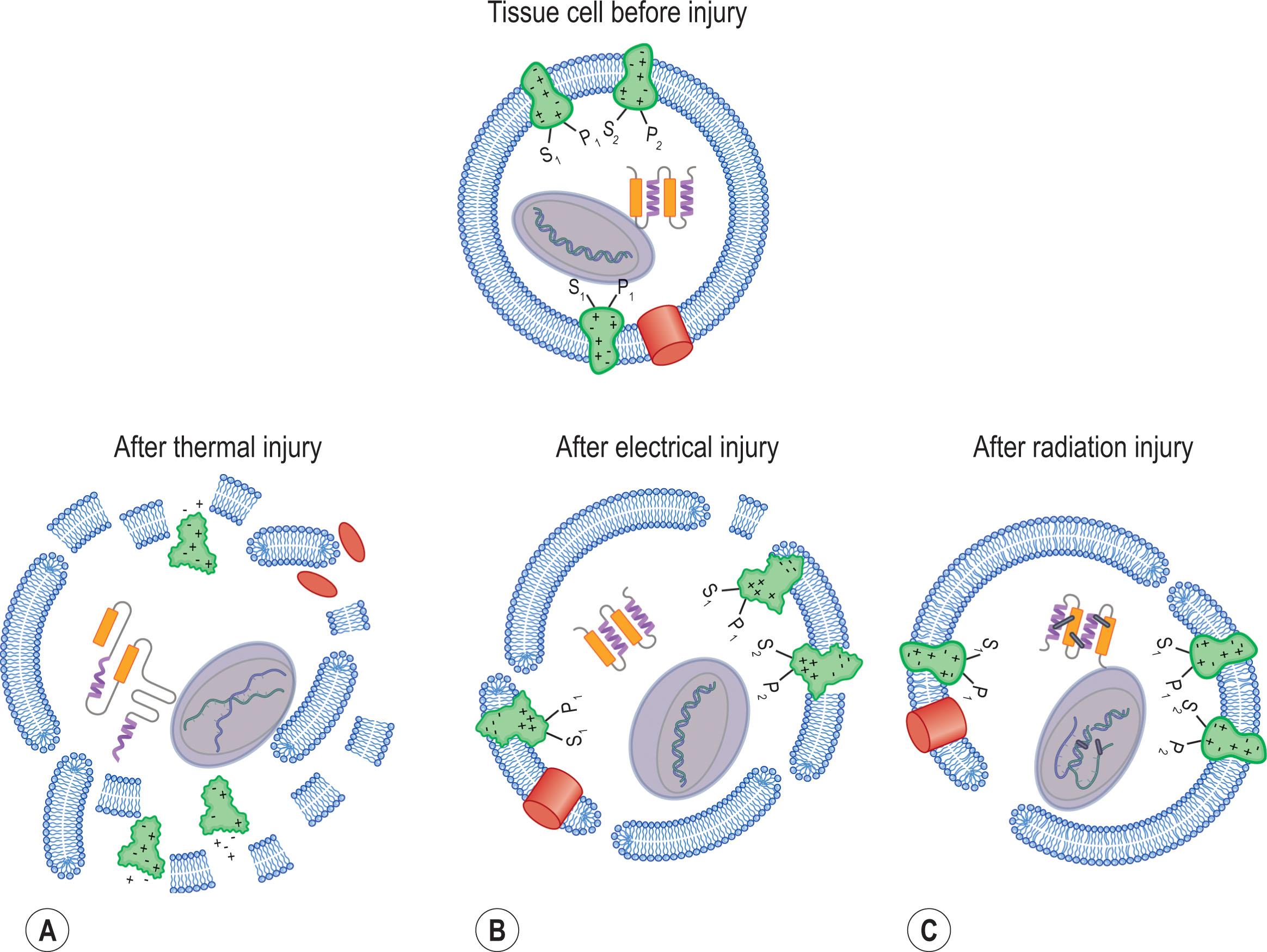
Tissue tolerance to hypothermic temperatures is tissue type specific. Neurological and neuromuscular tissues stop functioning at temperatures less than 21°C for more than 20–30 minutes because electrical and chemical signaling stops working. Skin tolerates hypothermia for longer time frames (i.e., 19–24 hours). At temperatures below freezing the mechanism of injury changes. Freezing with ice formation in any tissue causes damage by disrupting cell membranes and denaturing cellular proteins.
Frostbite is a clinical diagnosis applied to tissues injured by freezing. Freezing temperatures result in disruptive intracellular ice formation and denaturation of proteins. Ice formation in tissues concentrates electrolytes around proteins that leads to protein unfolding and aggregation. Tissue freezing also dehydrates cells in addition to promoting ice crystal propagation through cell membranes. The thaw cycle also causes injury by osmotic rupture of tissue cells that survived the freezing process.
Loss of circulation in the frozen tissue, as well as the reperfusion consequences on rewarming, also contribute substantially to the molecular denaturation of frostbite injury. Demographically, the majority of frostbite cases arise in the homeless or disabled populations in climates with cold winters. Ethanol consumption accelerates cool-down by increasing vasodilatation and rapid heat loss. Most commonly, distal extremities, ears, and other ambient air-exposed areas of the face are involved.
Burn injuries in children typically involve home cooking accidents. Another 10% of pediatric burns are due to non-accidental injury, and these burn victims will occasionally have other non-burn-related trauma. Diagnosing pediatric burns also involves an investigative component to understand the risk factors that precipitated the burn. A social history is extremely important. Abuse is more common in poor households with single or young parents. Detecting these injuries is important, as many children who are repeatedly abused eventually suffer a fatal injury. Usually children less than 3 years old are affected. As with other non-accidental injuries, the history and the pattern of injury may arouse suspicion ( Fig. 18.7 ).
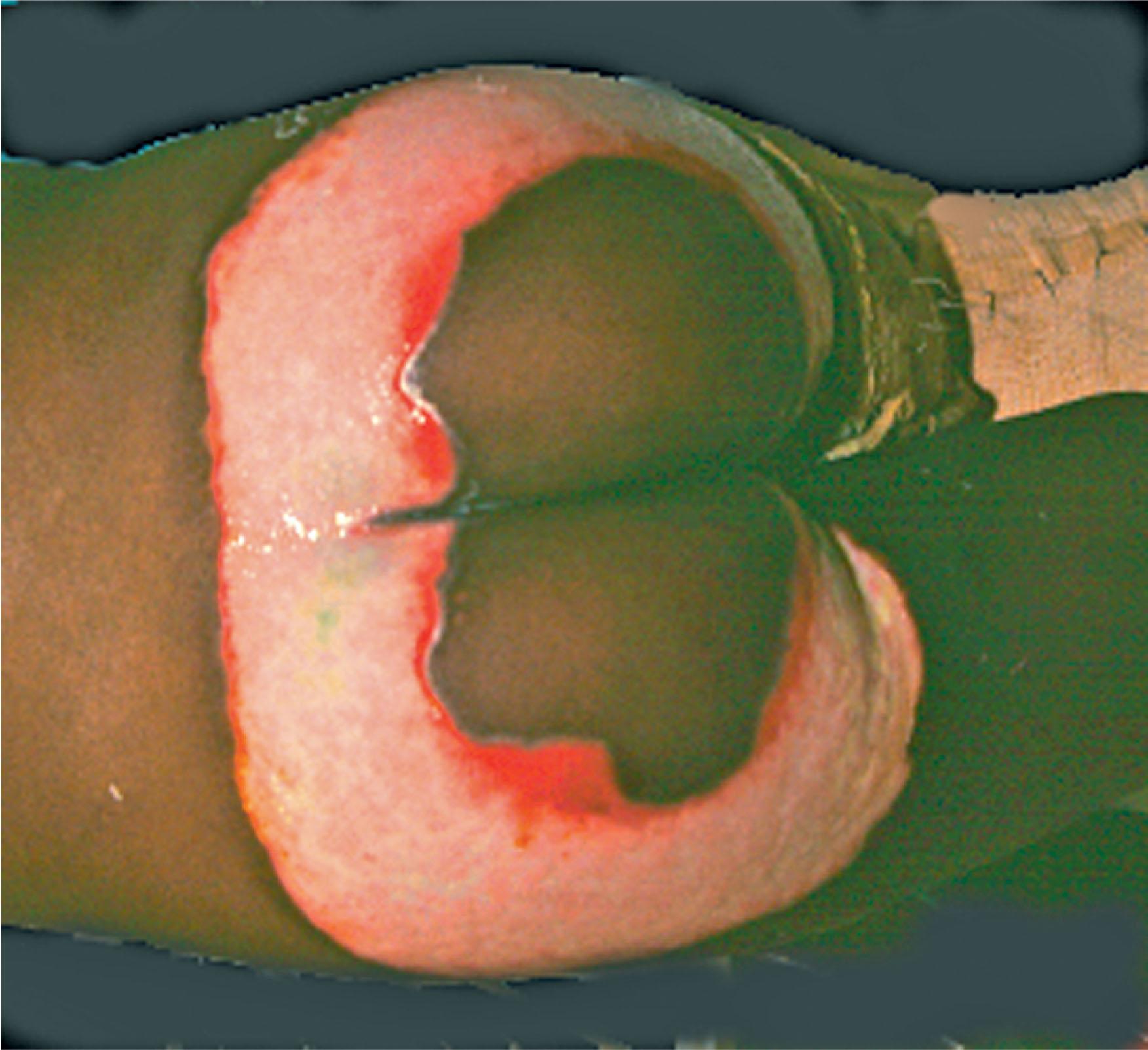
Burn center care with experienced pediatric burn resuscitation and pain management is more important than for young adults.
Chemical injury occurrences are roughly equally distributed between industrial and domestic situations. They most commonly result from inadvertent contact with toxic polishers, paints, cleaners or solvents. Cement burns make up approximately one-quarter of all chemical burns.
Current classification of chemical burns began with the efforts of Carl Jelenko III, who proposed stratification of chemical injuries into six broad categories based upon mechanism of action: reducing agents, oxidizing agents, corrosive agents, protoplasmic poisons, desiccants/vesicants, and acids/bases. The toxic chemicals involved are often strong acids or alkalis, especially in domestic disputes. Extent of tissue resulting from toxic chemicals are almost always dependent the concentration of the chemical, the duration of contact, mechanism of action of the chemical, and phase of the chemical agent (liquid, solid, or gas). The various mode of tissue damage range from redox reactions, corrosion, denaturation of proteins, disruption of cell membrane lipid bilayers, chelation of important ions, vesicants, and desiccants. Some chemicals actually cause thermal burns through exothermic reactions.
Chemicals diffuse into tissues causing damage until they are inactivated by reaction with tissue and/or removed by therapeutic intervention or by blood perfusion of the tissue. Different taxic chemicals behave the differently when in contact with tissue. Tissue injury caused by strong acid spills are characteristically less deep than those caused by strong bases. Acids denature proteins and dehydrate tissues, which makes the tissue less permeable to the acid (i.e., tanning). Tissue injury resulting from contact with strong bases results in hydrolysis, peroxidation and liquefication of tissue lipids. This facilitates tissue penetration to cause deeper penetration and damage to tissues. Some toxic chemical injuries to the skin may appear superficial because of minimal discoloration, but are actually deep dermal or full thickness. An example of this type of chemical injury is caused by skin contact with wet cement (i.e., calcium oxide [CaO]).
The most common acid burn injuries in humans result from contact with hydrochloric and sulfuric acids. These acids protonate glycoproteins and lipids, hydrolyze peptide bonds, and denature proteins. The result is denatured and dehydrated skin that resembles a thin, dry scab. Hydrochloric acid is often used in plumbing drain cleaners and in chemistry laboratories. Sulfuric acid has many industrial uses including lead–acid batteries, fertilizer, and wastewater processing. It is highly reactive against protein and lipids in water. It hydrolytically cleaves peptide bonds and deaminates amino side chains.
Both of these acids irreversibly damage the protein or phospholipids leading to molecular denaturation, exposure of hydrophobic groups, coagulation, and dehydration. The skin is white and dry when the damage is superficial and partial thickness, forming a hard, dry eschar under which ulcers may form.
Nitric acid is widely used in industry, especially in organic synthesis, metallurgy, photoengraving, polyurethane manufacturing, etc. Human exposure and contact are common. Nitric acid is very corrosive resulting in protein denaturation and dehydration. It hydrolytically cleaves peptide bonds and deaminates amino side chains. Highly concentrated nitric acid contact rapidly results in a depressed tan-colored scab on the skin. It is usually partial thickness and painful.
Chromic acid is commonly used in cleaning metal surfaces. This pungent, viscous, yellow liquid is made up of the active chemical metabolite chromic trioxide (CrO 3 ) in a solution of strong sulfuric acid. Contact leads to a range of irreversible damage to tissue proteins, protein coagulation, blister formation, and ulceration. It reaches peak serum levels by 5 h post-injury. Once in circulation, CrO 3 binds to hemoglobin and undergoes tissue uptake by the kidneys, liver, bones, lungs, and spleen within the first 24 h. Nephrotoxic damage leading to renal failure may result. Primary treatment consists of large volume water lavage for 15–20 minutes with a dilute solution of sodium hyposulfite. Then, rinse with buffered phosphate solution made up of 70 g of monobasic potassium phosphate and 180 g of dibasic sodium phosphate in 850 mL of water. Systemic manifestations are treated with 4 mg/kg of 2,3-dimercapto-1-propanol (dithioglycerol) given intramuscularly every 4 h for the first 48 h followed by 2 mg/kg daily for 1 week.
Hydrofluoric acid is used to etch glass. Exposure is particularly challenging to manage because fluorine is very electronegative. It strongly chelates calcium and thus penetrates tissue deeply, causing injury to nerves and muscles. Small splashes of high-concentration hydrogen fluoride products on the skin may not cause much inflammation or pain but may be fatal. Depending on the concentration and exposure duration of hydrofluoric acid, manifestations can be severe pain at the point of contact or a rash, which evolve into deep, slow-healing burns. Severe pain can occur even if no burns can be seen. Hydrofluoric acid can be toxic to the kidneys and lead to renal failure.
Hand contact from hydrogen fluoride may result in persistent pain, bone loss, and injury to nail bed. Eye exposure to hydrogen fluoride may cause prolonged or permanent visual defects, blindness, or total destruction of the eye.
An alkali is a water soluble base compound that when mixed with water produces heat and hydroxide ions. This reaction with water produces a pH that is higher than neutral. Alkalis such as lime, sodium hydroxide, and potassium hydroxide are common in household-cleaning soaps and detergents. Hydroxyl ions oxidize lipids (i.e., saponification) to generate water-soluble lipids. In addition, alkalis act to alter protein structure and disrupt cellular membrane structure. Strong alkalis are highly cytotoxic.
Sodium hypochlorite, household bleach, is a common cause of chemical burns. The active metabolite is hypochlorous (OCl − ), and toxicity arises from its oxidizing reactions on tissue. The severity of the injury is mostly dependent upon the concentration of the solution as opposed to the duration of exposure. Chemical skin burns from working with household bleach or hair treatment products can infect injury to the epidermis without significant immediate symptoms. Then hours later, painful blisters manifest. Very dilute hypochlorous acid (i.e., Dakin’s solution) is useful for cleaning contaminated wounds.
Cement burns are a common injury that is classically seen in patients kneeling in concrete. There are many constituents of cement; however, calcium oxide accounts for 65% of the content in the most mixtures. It acts as both a desiccant and an alkali. Injury is caused when calcium oxide reacts with water to become calcium hydroxide. The hydroxide is a strong base and causes tissue injury.
Become a Clinical Tree membership for Full access and enjoy Unlimited articles
If you are a member. Log in here